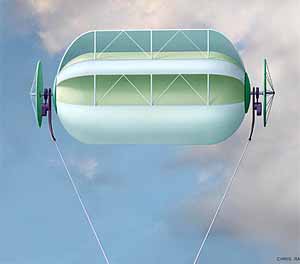 The Magenn Air Rotor System (MARS) is a tethered helium balloon device that generates power from the wind. The Magenn is a sizable blimp with rotating blades that rotates along its horizontal axis in response to wind energy.
The Magenn Air Rotor System (MARS) is a tethered helium balloon device that generates power from the wind. The Magenn is a sizable blimp with rotating blades that rotates along its horizontal axis in response to wind energy.
Like other similar devices, the electrical current that is generated travels down the tethering lines to a transformer at the ground station, then is redirected to the power grid. The lighter-than-air Magenn rotor seeks out the altitude that is optimal for highest winds.
The rotation of the blades also causes the rotor to ascend and stabilizes the MARS in its controlled environment. The height that the Magenn wind balloon will fly will be in the neighborhood of 600 to 1,000 feet, it’s efficiency nearing 50-percent and it can be placed near demand centers, which reduces the cost of transmission and loss of energy in transmission.
The Magenn system is also highly mobile and can be moved to near locations as wind conditions or business operations change. One such application is emergency relief situations where electrical power generation is needed.
While some other wind turbine systems may boast their virtues bordering on blathering hot air, the Magenn shows unusual promise in delivering on its projections. Keep an eye on the sky for Magenn Air Rotor Systems coming to a location near you.
The problem I see with a system like this is that helium is a small molecule that is difficult to contain. Consequently it tends to slowly, or not so slowly, leak away. That’s why helium party balloons go flat after a few days. Helium is relatively expensive since it is such a small percentage of air and must be obtained by fractional distillation of liquefied air. I wonder if the economics of replacing lost helium will result in economical power production from these units.